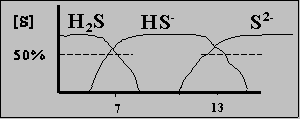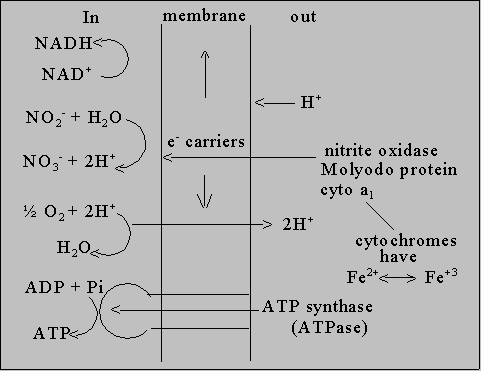| Instructor: Dr. David L. Kirchman (kirchman@udel.edu)
September 9, 1997 MAST 634 Lecture 2: Hydrothermal Vents Important Points of Last Lecture (9/4/97)
Source of energy for hydrothermal vents
Form of primary production: chemoautotrophs Can think of all life as redox reactions
e- donor
e- acceptor
A bit more complicated than that
C source e-
source Energy
What are chemoautotrophs?
very specialized; cannot use organic compounds
 So, at pH 8.0 (pH of Seawater) mostly HS- (delta)Go' HS-
+ 202 = SO42- + H+
-794
Oxidation State
Some important examples
Ammonium nitrite
nitrate
 Common traits: redox reaction 1. O2 is e- acceptor
Possible
Not possible
How to calculate energy yield?
p 434-441
Gibbs free energy
delta G > O; change in heat endergonic; not spontaneous
Redox reaction
Example: NO2- oxidation with O2 Divide into half-reactions
Look for reduction potential in table
Eo (V)
Notes
sum of half reactions: delta Eo = Eo e acceptor - Eo e donor In this example
How to relate to delta G?
Note: if delta E > O, then delta G <O, i.e. reaction goes!
0.39 V * 96,494 J V-1 mol-1 *2 = 75270 J mol-1
Is this a lot? No, small compared to oxidative phosphorylation
NADH + O2 = NAD+ + H2O
Again, energy obtained from oxidation of NO2-
small to that requred to synthesize NADH
How does microbe get reducing power and energy? Reverse e- flow
 Proton-motive force Delta G = 2.3
RT[pHIn- pHout] + ZF delta psi
Mitochondria delta pH = 0.75 higher outside
~ 210,00 V cm-1 over 80A o.: delta G = -21.5 kJ mol-1 Bottom Line
Importance of symbiotic chemoautotrophic Bacteria at Hydrothermal vents Vent communities supported by chemoautotrophy
First Example
Phylum Vestimentifera
Evidence of symbiosis
enzyme unique to autotrophy
How to study
Isolate RNA
Results
Note limitations
Distel and Cavanaugh (1994) How do different types of symbiontic bacteria compare? DNA
Clone into "TA vector"
What is cloning? Putting "foreign" DNA into a self reproducing vector which in turn goes into host (usually bacteria) See p 901 of book for overview of cloning One plasmid + insert ----> one bacterium ----> one colony (many bacteria) on Cloning PCR products
What does PCR product look like?
 "blunt ends
"blunt endsIn fact: Extra A at 3' end can be removed or you can take advantage of the A Design vector with T  Vector and insert will join by base-pairing between T and A. Need to "cement" vector-insert with ligase What did they find?
|